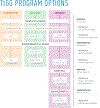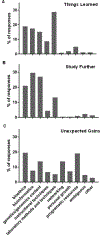Teaching the Genome Generation: Bringing Modern Human Genetics into the Classroom Through Teacher Professional Development
- PMID: 31667467
- PMCID: PMC6821449
- DOI: 10.15695/jstem/v1i1.12
Teaching the Genome Generation: Bringing Modern Human Genetics into the Classroom Through Teacher Professional Development
Abstract
Teaching the Genome Generation (TtGG) is a teacher professional development program and set of high school biology lessons that support interwoven classroom instruction of molecular genetics, bioinformatics, and bioethics. Participating teachers from across New England implement the modular elements of program at a high rate in a variety of biology classrooms. Evaluation data collected over three academic years (2014/15 to 2016/17) indicate that TtGG has increased teachers' abilities to integrate complex concepts of genomics and bioethics into their high school classes.
Keywords: Bioethics; Bioinformatics; Genetics; Genomics; High School; Laboratory; Professional Development; Teacher.
Figures




References
-
- Chi M (1997). Quantifying qualitative analyses of verbal data: A practical guide. Journal of the Learning Sciences, 6(3), 271–315.
-
- Garber KB, Hyland KM, and Dasgupta S (2016). Participatory genomic testing as an educational experience. Trends in Genetics. 32(6), 317–20. - PubMed
-
- Goldstein JA, and Blaisdell J (1996). Genetic tests which identify the principal defects in CYP2C19 responsible for the polymorphism in mephenytoin metabolism. Methods in Enzymology, 272, 210–8. - PubMed
-
- Green ED, and Guyer MS (2011). Charting a course for genomic medicine from base pairs to bedside. Nature, 470(7333), 204–13. - PubMed
Grants and funding
LinkOut - more resources
Full Text Sources
